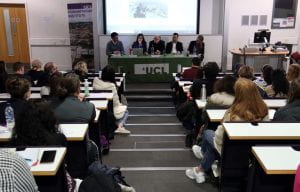Natural Hazards, Conflicts and Disasters in the Himalayan Region
By Saqar ' M Al Zaabi, on 3 March 2020
Written by IRDR Master’s student Ronja Lutz
The UCL Humanitarian Institute evening conference, held on 19 February 2020 and chaired by Prof Peter Sammonds, presented a panel of four speakers giving diverse perspectives on disaster relief in the Himalayan region.
 Dr Jessica Field from Brunel University gave the first talk. She introduced the history of disaster relief in India in order to zoom in on the situation in Ladakh. She characterised disaster governance in this region of Northern India as focused on top-down security and military interventions, relief practices as centred on hazards, and being reactive rather than proactive. Of particular interest was her analysis of relief work in the context of different actors, governmental and non-governmental, competing for legitimacy.
Dr Jessica Field from Brunel University gave the first talk. She introduced the history of disaster relief in India in order to zoom in on the situation in Ladakh. She characterised disaster governance in this region of Northern India as focused on top-down security and military interventions, relief practices as centred on hazards, and being reactive rather than proactive. Of particular interest was her analysis of relief work in the context of different actors, governmental and non-governmental, competing for legitimacy.
The second talk, by Sultan Bhat of Kashmir University, was focusing on factors that make the Kashmir valley vulnerable to hazards such as floods. He then highlighted changes due to tourism, such as deforestation, expanding settlements, that lead to increased vulnerability. In a long-term overview spanning several centuries, he was able to show that not only vulnerability but also the occurrence of floods in the Kashmir valley has increased.
Third up was Dr Punam Yadav from UCL’s Institute for Risk and Disaster Reduction (IRDR), presenting on the conflict in Nepal and its effects on women. She gave an overview of Nepal’s Civil War 1996–2006, in the wake of which around 70,000 people are still displaced. Despite the numerous negative effects of conflict, Dr Yadav pointed out how conflict can create spaces for women. For example, the political representation of women has increased from 6% to 33% after the introduction of a quota in 2007, and 20% of combatant roles in the military are now reserved, arguably due to women’s involvement in civil war combat.
 The final talk by IRDR’s Akhtar Alam gave a broader overview of the challenges to disaster risk reduction in the Himalayas in the future. After surveying the numerous natural hazards in the region, including earthquakes, flash floods, and landslides, he pointed out that despite a high occurrence of hazards across the whole region, the vulnerability of certain regions is what ultimately determines fatality rates. For example, Myanmar and Bangladesh saw relatively few incidents compared to other regions, but a very high death toll. Consequently, he urged for increasing resilience to natural hazards, for example by improving and enforcing building standards in the face of earthquake risks. Similar to Dr Field, he cited a focus on response instead of prevention and a neglect of community involvement as obstacles to preventing disasters in the Himalayan region.
The final talk by IRDR’s Akhtar Alam gave a broader overview of the challenges to disaster risk reduction in the Himalayas in the future. After surveying the numerous natural hazards in the region, including earthquakes, flash floods, and landslides, he pointed out that despite a high occurrence of hazards across the whole region, the vulnerability of certain regions is what ultimately determines fatality rates. For example, Myanmar and Bangladesh saw relatively few incidents compared to other regions, but a very high death toll. Consequently, he urged for increasing resilience to natural hazards, for example by improving and enforcing building standards in the face of earthquake risks. Similar to Dr Field, he cited a focus on response instead of prevention and a neglect of community involvement as obstacles to preventing disasters in the Himalayan region.
The event was live-streamed and you still can watch the video on the Institute for Risk and Disaster Reduction YouTube channel: https://youtu.be/dhYU0MuJf3g
 Close
Close

